Behavioral segmentation might be a challenge even when it’s based upon an already existing classification. Let alone creating your own. To spare you time and effort, UXPressia provides a special means — personalities for Personas.
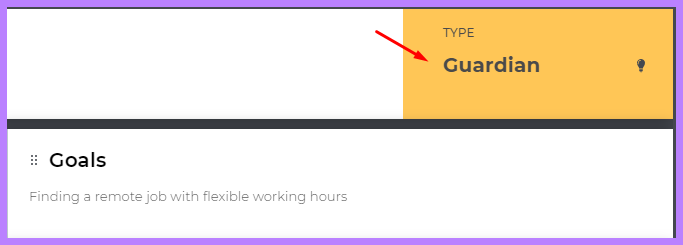
Read on to learn more about personality types and how this functionality works in UXPressia.
Contents
What is a personality type?
To put it shortly, it’s a combination of traits determining one’s behavior, mindset, emotions, and motivations. Each type has unique qualities and shortcomings, strengths and challenges. Each gives a new angle to look from.
Why define a personality type?
The same Persona, depending on their personality type, thinks and behaves differently. Just one variable fundamentally affects their needs, pains, goals, and emotional experience. Consequently, your ideas and opportunities for improving user/customer experience will vary too. Of course, assigning Personality is optional, but it’s a good opportunity to take a different approach and see some things you probably never noticed before. Sometimes, it may lead to a completely different strategy, such as repurposing social media content, tweaking video marketing campaign plans, or enhancing the customer care system.
Default personality types in UXPressia’s Personas Tool
In our tool, we use the personality types defined by Dr. David Keirsey. You can check the primary source to get the fullest possible information. There are many other typologies, from Myers-Briggs Type Indicator to Socionics, but Keirsey’s classification is more insightful for design purposes and easier to grasp. It’s general enough to reveal representative patterns and detailed enough to go deeper if need be.
So, here are the types of personality to investigate and recognize your customers in. It’s the Rational, the Artisan, the Guardian, and the Idealist.
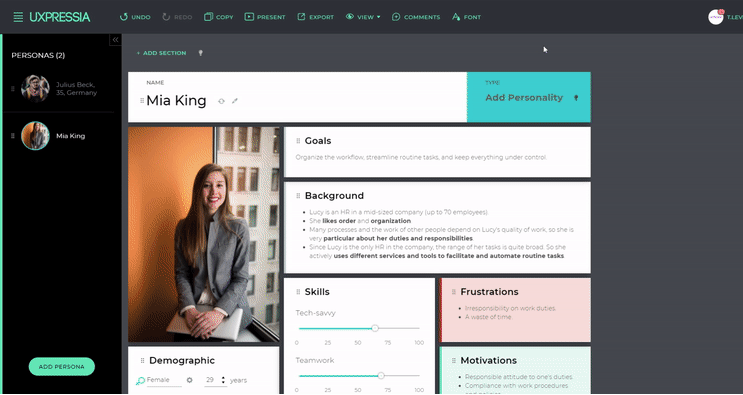
Now let's have a closer look at each type.
Guardian type personas
“I want my family to have anything they need, but I'm also realistic. In two years, our older daughter will go off to college. It's not the best time to buy a second car, and we have a one-car garage while winters are snowy and cold. All in all, carsharing is a true blessing.”
Key features:
- Titles matter; experience is important. “A recent graduate can’t give me good advice. I prefer to deal with at least a senior manager.”
- Significant people in their lives deserve the best. “I save money for my son’s education. That’s why I rarely eat in restaurants.”
- They follow the trodden path. “I buy the same fragrance over and over again. At the same store. I know this place, I like this perfume. Why change? Why bother?”
- They are conservative, law-abiding, respect traditions, and expect others to follow their example. “They had no physical menu card, can you believe it? I had to scan a QR code to access its digitized version. No wonder I left hungry.”
- They search for something that improves their lives without changing them much. “I’d rather buy a dish-washing machine, a robot vacuum, and anything to ease my daily routine than hire a cleaning service. I'm not comfortable with strangers touching my things.”
- They use the money wisely, treat things with due care, and prefer to repair something rather than replace it. “It took me a while to choose a smartphone, but I’m pretty sure it will serve for a long time. I also paid for the extended warranty. Just to be safe.”
- Long-term decision-making, intense attention to detail. “I can go through hundreds of customer reviews, discuss all options with my family, delve into the specs. I hate being rushed.”
Artisan type personas
“I stumbled upon this app and was immediately hooked. Short and funny descriptions, tons of pics, reviews, promo videos, a user-friendly interface, quick customer service responses… I came, I saw, I rented.”
Key features:
- They always seek the finer, the best, the latest something. “I'm choosing a new coat. The one I bought last season is already out of fashion.”
- They are in constant search of adventures and bright impressions. “Some say I spend too much money on museums, movies, video games, and weekend trips. I say it’s an investment in my mood.”
- The ends justify the means, especially when some fun is expected. “I’m so eager for Lady Gaga’s show. I'll pay whatever it costs!”
- They live fast and die young (when you keep them waiting). “I live in a small town. Some goods are out а my reach, literally. Yet delivery takes ages. So I choose only those brands I can access personally.”
- Sensory decision-making. Colors, textures, flavors, even a gut feeling control their minds. “The coffee was meh, but I fell in love with the place itself. Guess I should give them a second chance.”
- They are spontaneous and don’t care much about the future or possible consequences. “I got a dog, then got a new job. Long story short, I’m looking for a dog walker, ‘cause now I’ve no time for this.”
- Even the most ordinary things must be extraordinary to draw their attention. “Yep, my toothbrush has a light-up timer. Isn’t it awesome?”
Idealist type personas
“Transport-related air pollution is a serious problem. But driving a car enables me to find new homes for shelter animals. That is when the ends justify the means.”
Key features:
- Dreams seem more real to them than physical senses. “I watched Black Swan, got very excited about taking ballet classes, and immediately ordered pointe shoes online. To be honest, I don’t have time for dancing, but can’t stop imagining myself on stage.”
- They are all about what might be and future possibilities. “I installed this dating app just in case. What if my ideal partner is waiting for me inside?”
- They prioritize personal development and growth. “I spare no expense for courses and workshops. Knowledge is power, right?”
- They merge and associate themselves with anything they consume, use, or do. “We have to belong, you know, me and the team, me and the brand I’m gonna promote. Or it's not going to work.”
- They are hungry for novelty, any routine kills their interest. “I love accessories! Phone cases, costume jewelry, headscarves, and anything I can use to shake things up a bit.”
- They lean toward personal interactions, real emotions, and special bonding. “Their community manager is amazing! I don't care whether other services are better. I’m sticking with this one.”
- Noble goals, intangible assets, and harmony are high on their agenda. “I’d never purchase a thing from a company that tests or experiments on animals.”
Rational type personas
“Driving carsharing enables me to move wherever I want and change directions whenever I want. I like to be independent and on my own.”
Key features:
- They are self-confident and quick in their decisions. “I hate going shopping with my friends. I always know what I came for. Them? Hours of hanging around and zero purchases in the end.”
- They have a macro-level perspective. Every step they take must have a purpose. “My doctor made a case for a preventive health screening. So it doesn’t feel like a waste of money.”
- Reality is a challenge in all of its aspects and must be reshaped into something better. “I always give feedback to developers. A few minutes of my time can improve a service and customer experience.”
- They strive for order and have A-Z plans for all occasions. “I use five taxi apps. When one service can’t provide me a car, I just switch to another. That’s it.”
- No authorities, no idols. “Buying something a blogger did recommend? Why would anybody do that?”
- Emotions and chances are nothing. Logic and facts are everything. “My parents don’t get why I rented this apartment. Bad view out the window, no parks anywhere near. But it’s two blocks away from my office and there’s an all-day shop on the corner. I work late, so it fits perfectly.”
- They like to be alone and value their privaсy. “Sales calls make me violent. I didn’t forget how to use my phone, I’ll contact you when I need it. Just leave me be!”
How to choose a personality type for your persona?
One way is to compare how users or customers describe their experience to the key features we listed above.
Not all patterns within a type must match your Persona’s behavior to define its personality. Also, mind your domain. Some people are pragmatic when it comes to major expenditures but spend like a drunken sailor on the simpler pleasures of life. Such a Persona can be Rational for a realtor and Artisan for a coffee shop owner.
Too complicated? Take a shortcut.
Answer two simple questions:
1. Does your Persona act fast or take time to read reviews, compare prices, and think everything over?
2. Is your Persona guided by feelings or facts?

Impulsive and emotional people belong to Artisans. Idealists are cautious and empathetic. Quick and logical Personas fall into the Rational type. Finally, those who are factual and concerned can be called Guardians.
We also left some clues in the Personality/Type window. Point to a type to summon it.
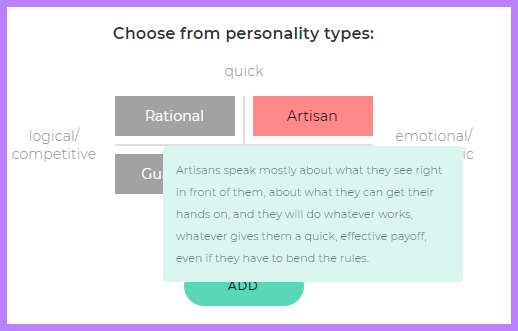
If you deal with a lack of resources, create Personas only within the most common personality types in the world — the Guardians and the Artisans. Thus you’d cover almost 80% of your current and potential audience. Yet, it wouldn’t work for specific industries, businesses, and companies. Producing vegan goods, don’t neglect the Idealists. Running a high-tech start-up, don’t dismiss the Rationals.
What’s next? Insights are coming
Once the Personas and the personality types are matched, you have a unique perspective on what’s to be done.
For example, to win Rationals over, give them the most effective solution. Provide tools to compare and see actual benefits. Don’t be too pushy, stimulate their curiosity instead. Your service should save them time for more pressing matters to do. Choose a simple, clean design, automate the processes, minimize personal contact. Sell features and challenges.
Artisans are eager for handy services and appealing products. Everything needs to be visual. Use different high-quality images with short descriptions and clear calls to action. The fewer steps, literally or figuratively, the purchase away, the better. Build hype and stories around your business. Sell experiences and impressions instead of practical utility. Be friendly, funny, and fast. Awake their senses to seal the deal.
Guardians must be provided with detailed information about your goods and services to compare alternatives. Keep the data easy to follow and true to fact. Develop their trust by showing you are a decent person, your product is safe to use, and your service is quite reliable. Protect your reputation, make guarantees, and sell quality. Be polite, honest, and keep your word. Give a reason to take your offer.
Everything you present to your customers must be easy to use and as simplistic as possible. For instance, invoices are often overlooked, and it can take time to plan the perfect ones. However, there are many templates you can choose from that could please your customers.
Idealists want your product or service to be trustworthy. Make sure your company’s values are in line with theirs. Launch impactful social campaigns to promote your business. Show how it helps other people or changes the world. Sell dreams, promises, and inspiration. Forget the bots, embrace personal communications. Be concerned, lend your shoulder, lead by example. Sow motivation, reap happy customers, users, and partners.
All such insights can be turned into helpful tips to enter in the description field of your Persona’s type. To see them, hover a cursor over the lightbulb icon.
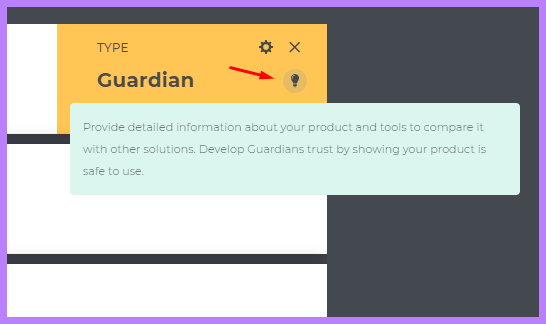
When you're feeling creative
If you have other persona types in use, feel free to add them here:
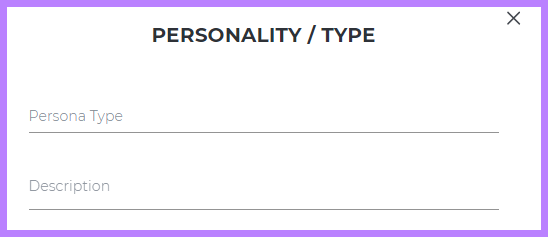
This functionality is also good to distinguish between buyer/user or internal/external personas, or use whatever grouping makes sense in your particular case.
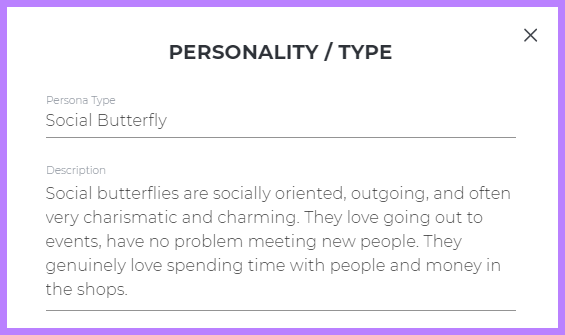
What to make of it?
A personality type is not a mandatory step. It’s rather an extra dimension to put your Persona in. Defining a personality gives you a new perspective to consider user or client experience from. In the UXPressia’s Personas Tool, you’re free to use the default typology or bring and insert your own.
We hope building personas in the frame of personality type will hit a whole new mapping level for you. Don’t hesitate to try our tool and get valuable insights into your customer and user experiences.
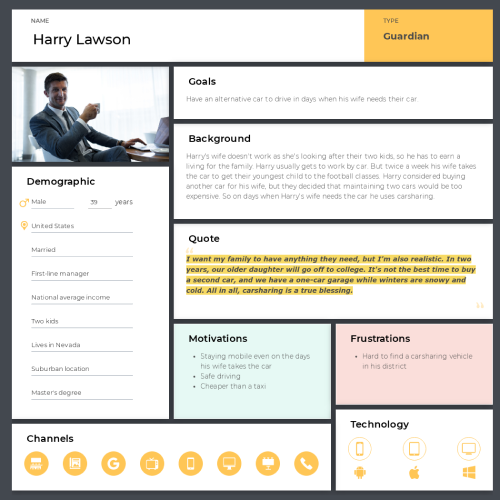
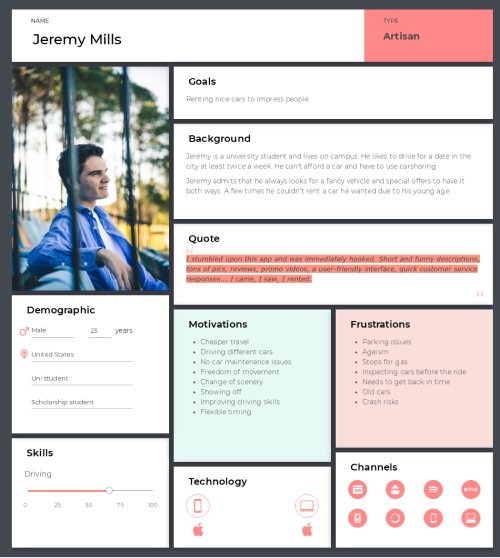
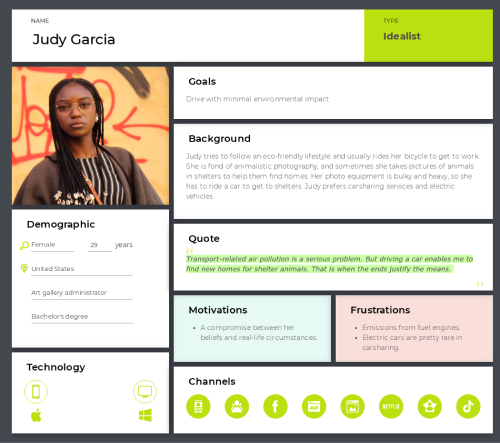
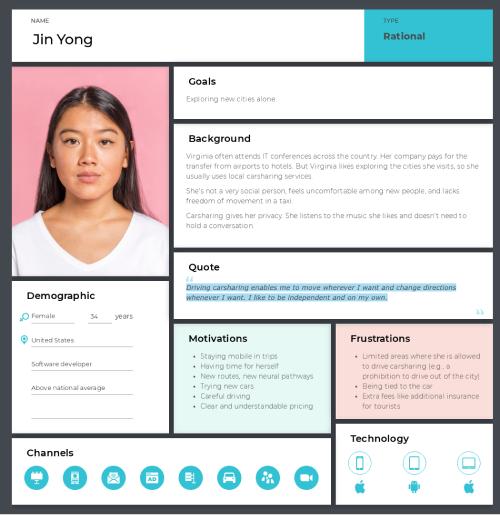


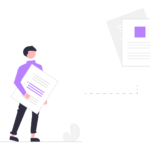



What an interesting dimension to add. Seems like it can lead to a better understanding of motivations, frustrations, and decision drivers a persona has. Even though I think people with different persona personality types can often face similar user experience problems, they would definitely have different solutions perform better depending on specific needs and expectations.